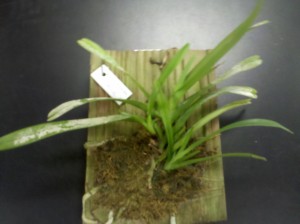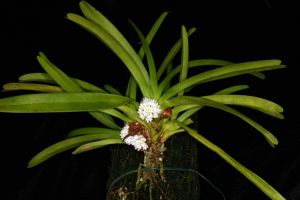Erin Billingsly, and Gwen Clarke are researching Ancistrorhynchus metteniae (Kraenzl.), a member of the Aerangidinae subtribe. It is generally found in Nigeria, Sierra Leone, Central African Republic, Cameroon, Equatorial Guinea, Gabon, Zaire Ethiopia, Uganda, and Tanzania. It grows most successfully at elevations 0f 900 to 1300 meters in shady, warm (between 68-75 deg. F), and humid environments. It is typically a small to medium sized epiphyte growing up right on other vegetation, typically trees. Their small flowers rarely open fully, and do not last long. The flowers are only about a cm in length, and blooms in October on the lower leaves. It has multiple blossoms, and the leaves are thin, flat, and narrow. The leave generally grow 5-25 cm in length. As the plant grows the leaves appear to be stacked, growing vertically. They have a bright green coloration, and the flowers are white.
Our sample is still growing, but due to the size of the habitat, not sure how much more it will grow. Here is a picture of a larger blooming orchid below with a closer view of the flower underneath.
The Ancistrorhynchus metteniae was named after a German orchid enthusiast (Metteniae in the late 1800’s
http://www.orchidspecies.com/ancimetteniae.htm
Angraecoid Orchids. Stewart, J., Hermans, J., Campbell, B., Timber Press, Copy write 2006.



#1 by armstronggenetics on March 2, 2011 - 4:39 pm
This represents a solid start. First, I noticed a few errors in spelling… subtripe sounds like it might be part of the stomach 😉 Proofread for other errors and readability. As mentioned in a recent post to the About the blog, I asked everyone to eliminate common names from their posts. (You can keep the info on how Metten was an orchid enthusiast but delete “Metten’s… “.) All authors were asked to obtain and post a quality image of the actual specimen from which they extracted DNA. Finally, it would be good to have a more close-up image of the flowers included.. as no detail is provided by the current image (However, I like it because it gives perspective on size of flowers to plant).